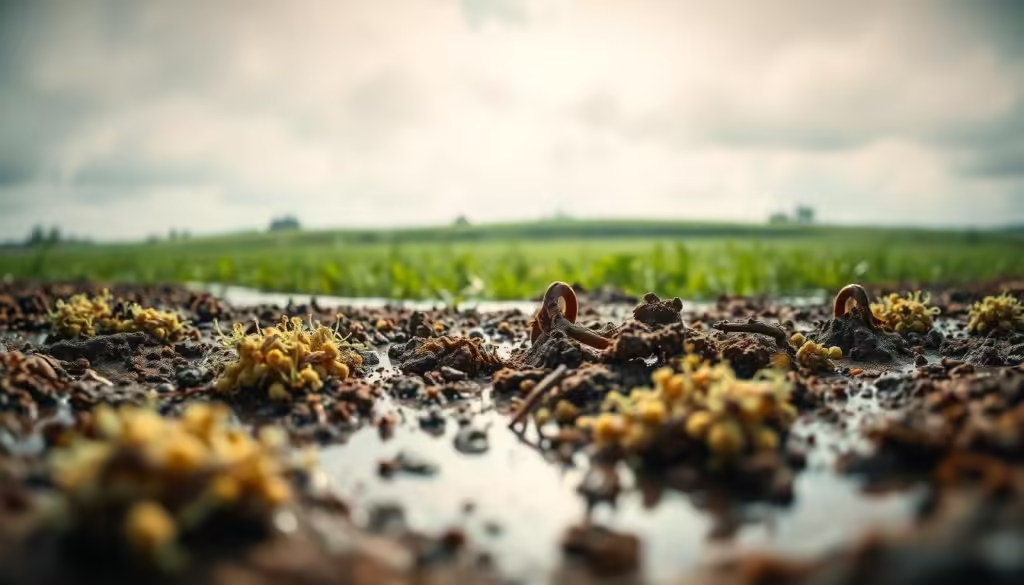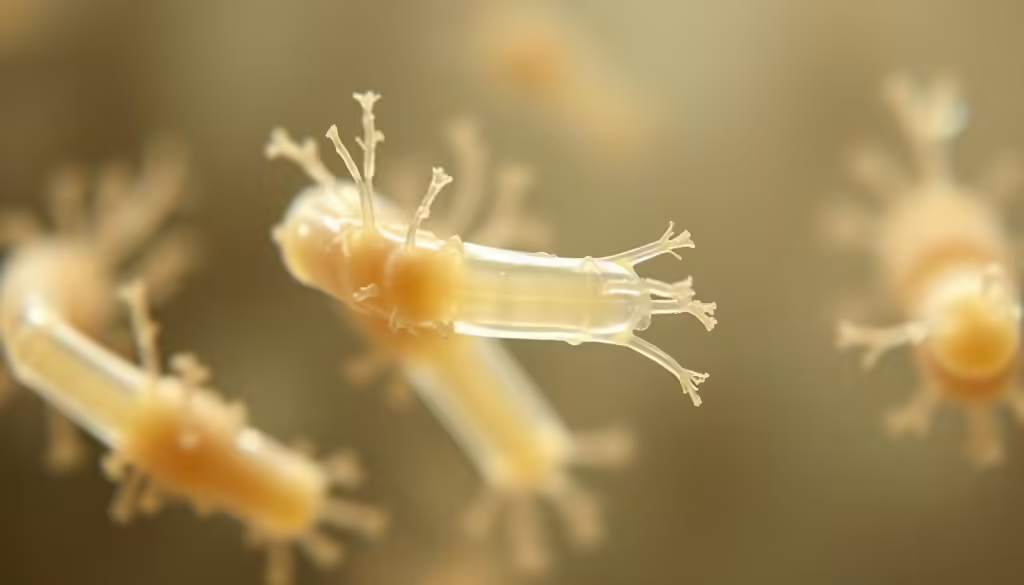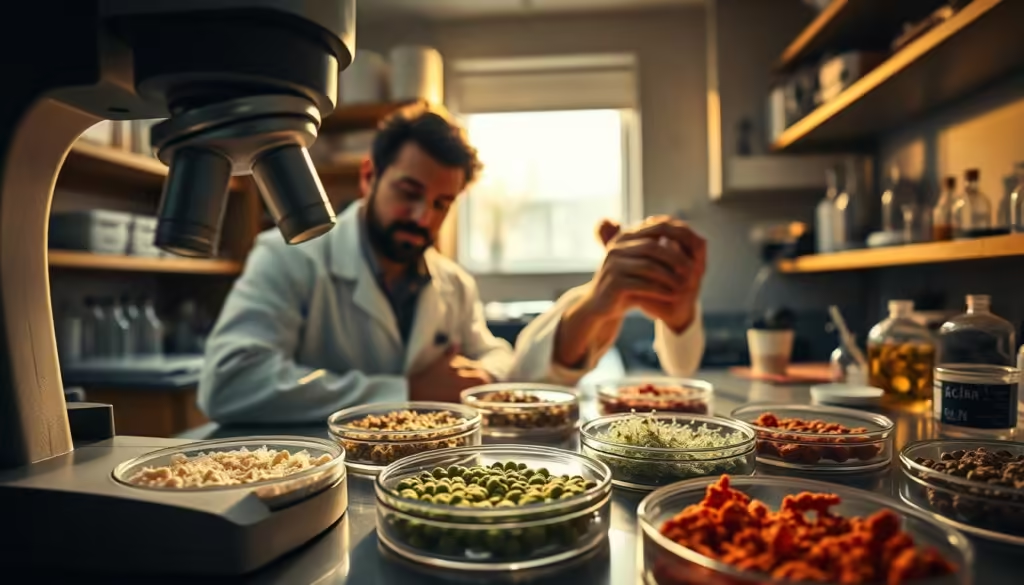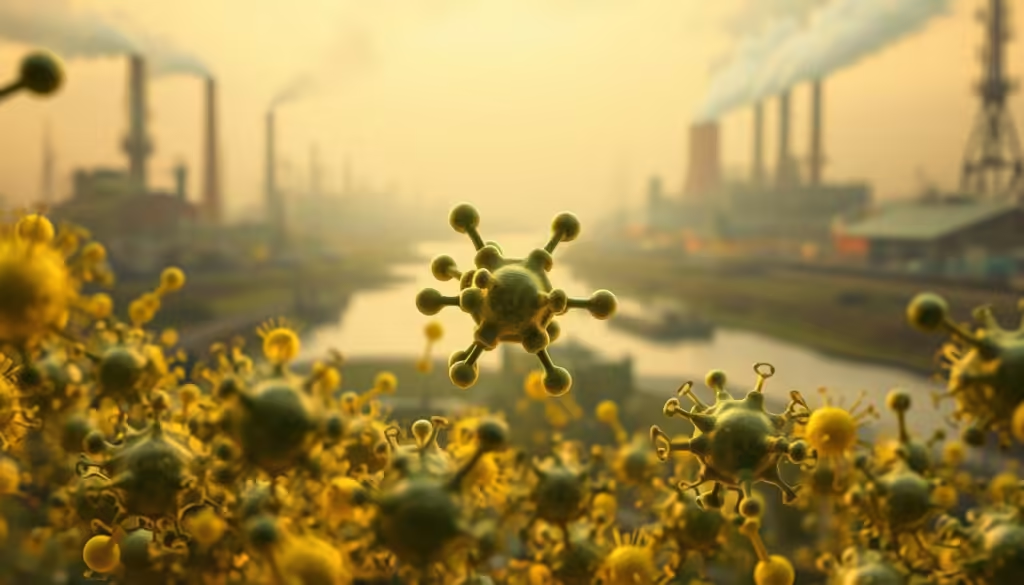Oil spills have devastating effects on our planet, contaminating water and soil, and harming wildlife. However, biotech is providing a promising solution. By leveraging bacteria that naturally break down pollutants, scientists are developing innovative ways to clean up these environmental disasters.
This approach utilizes the power of biotech to enhance the natural process of biodegradation, where bacteria feed on the pollutants, rendering them harmless. This method is not only effective but also environmentally friendly.
Key Takeaways
- Biotech is being used to clean up oil spills by leveraging bacteria that break down pollutants.
- This approach is environmentally friendly and effective.
- The process enhances the natural biodegradation of pollutants.
- Bacteria are used to feed on the pollutants, rendering them harmless.
- This innovative solution is promising for addressing environmental disasters.
The Environmental Impact of Oil Spills
The devastating impact of oil spills on the environment is a pressing concern that requires immediate attention. Oil spills have far-reaching consequences, affecting not just the immediate environment but also having long-term effects on ecosystems.
Immediate Ecological Consequences
Oil spills result in immediate and dramatic ecological consequences. The impact on marine and coastal environments is particularly severe.
Effects on Marine Life
Marine life is directly affected by oil spills. Oil coats the fur and feathers of animals, impairing their ability to regulate body temperature and fly. Moreover, ingestion of oil can be toxic, leading to poisoning and death. Many species, including fish, birds, and mammals, are vulnerable to the toxic effects of oil.
Coastal Ecosystem Damage
Coastal ecosystems, including mangroves and salt marshes, are crucial for biodiversity. Oil spills can damage these ecosystems, leading to the death of plants and animals that depend on them. This not only affects the local wildlife but also has broader ecological implications, as these ecosystems provide important services like shoreline stabilization and water filtration.
Long-term Environmental Damage
The environmental damage from oil spills is not limited to the immediate aftermath. Long-term effects can persist for decades, affecting the recovery of ecosystems. Chronic oil pollution can lead to the accumulation of toxic substances in the food chain, impacting human health and wildlife alike.
Limitations of Traditional Cleanup Methods
Traditional methods of cleaning up oil spills, such as skimming and chemical dispersants, have limitations. These methods can be ineffective in certain conditions and may cause additional environmental harm. For instance, chemical dispersants can be toxic to marine life, and their use is controversial.
Understanding Bioremediation: Nature's Cleanup Crew
By harnessing the power of microorganisms, bioremediation provides an effective and eco-friendly method for mitigating the impact of oil spills and other environmental contaminants. This natural process leverages the capabilities of various microorganisms to degrade pollutants, restoring ecosystems and promoting sustainability.
What is Bioremediation?
Bioremediation is a biological process that utilizes microorganisms, such as bacteria and fungi, to break down or transform pollutants into their less toxic or harmless forms. This technique is particularly useful for addressing contamination in soil, water, and other environments.

How Microorganisms Break Down Hydrocarbons
Microorganisms play a crucial role in bioremediation by employing various mechanisms to degrade hydrocarbons. Two key processes involved are enzymatic processes and metabolic pathways.
Enzymatic Processes
Enzymes produced by microorganisms catalyze the initial steps in hydrocarbon degradation, breaking down complex molecules into simpler compounds. These enzymes are highly specific, targeting particular types of hydrocarbons.
Metabolic Pathways
Once enzymes have broken down hydrocarbons into simpler compounds, metabolic pathways within the microorganisms further process these substances, ultimately converting them into carbon dioxide, water, and other harmless products.
The Science Behind Bacterial Degradation
Bacterial degradation is a critical component of bioremediation, with certain bacteria specializing in the breakdown of specific hydrocarbons. Understanding the science behind bacterial degradation is essential for optimizing bioremediation techniques and enhancing their effectiveness in environmental cleanup.
Bioremediation, supported by green tech, offers a promising solution for addressing environmental pollutants, aligning with global sustainability goals.
Meet the Microbes: Bacteria That Feast on Oil
Certain bacteria have developed unique capabilities to break down hydrocarbons, making them invaluable for oil spill cleanup efforts. These microorganisms are the unsung heroes of bioremediation, utilizing their metabolic processes to degrade complex oil components into simpler, less harmful substances.
Alcanivorax and Other Hydrocarbon-Eating Specialists
Alcanivorax is a genus of bacteria known for its ability to consume hydrocarbons. These bacteria are found in marine environments and are particularly adept at breaking down alkanes, a major component of crude oil. Alcanivorax borkumensis is a notable species that has been studied extensively for its bioremediation potential.
Pseudomonas and Versatile Degraders
Pseudomonas is another genus of bacteria that plays a significant role in hydrocarbon degradation. These bacteria are known for their versatility, capable of breaking down a wide range of organic compounds, including polycyclic aromatic hydrocarbons (PAHs). Their adaptability makes them valuable for bioremediation efforts in diverse environments.
Microbial Communities and Synergistic Effects
The effectiveness of bioremediation is often enhanced by the presence of microbial communities, where different species work together to achieve a more comprehensive breakdown of pollutants. Within these communities, processes such as biofilm formation and nutrient cycling are crucial.
Biofilm Formation
Biofilms are complex communities of microorganisms that adhere to surfaces. In the context of bioremediation, biofilms can enhance the degradation of hydrocarbons by providing a protective environment for bacteria to thrive and interact.
Nutrient Cycling
Nutrient cycling within microbial communities is essential for maintaining the health and activity of bacteria involved in bioremediation. The exchange of nutrients supports the growth of diverse microbial populations, contributing to the overall effectiveness of the cleanup process.

| Bacterial Genus | Key Characteristics | Bioremediation Potential |
|---|---|---|
| Alcanivorax | Specialized in degrading alkanes | High potential for marine oil spill cleanup |
| Pseudomonas | Versatile, degrades various hydrocarbons | Effective in diverse environments, including soil and water |
Green Technology for Earth's Sustainability: Biotechnology Applications
As the world grapples with the challenges of oil spills, biotechnology emerges as a key player in the quest for effective cleanup solutions. The integration of green technology in environmental remediation processes is revolutionizing the way we approach pollution.

Genetic Engineering for Enhanced Degradation
Genetic engineering plays a crucial role in enhancing the degradation capabilities of microorganisms. By modifying bacterial strains, scientists can create microbes that are more efficient at breaking down hydrocarbons and other pollutants.
Optimizing Bacterial Performance
Optimizing bacterial performance is critical for effective bioremediation. This involves strategies such as nutrient addition and optimizing environmental conditions.
Nutrient Addition Strategies
Nutrient addition is a technique used to stimulate the growth and activity of beneficial microorganisms. By providing the necessary nutrients, bacteria can thrive and degrade pollutants more effectively.
Temperature and pH Optimization
Temperature and pH levels significantly impact bacterial performance. Optimizing these conditions can enhance microbial activity, leading to more efficient degradation of pollutants.
Creating Specialized Microbial Consortia
Creating specialized microbial consortia involves combining different bacterial species to achieve synergistic effects in pollutant degradation. This approach can lead to more robust and resilient bioremediation processes.
By leveraging green technology and biotechnology, we can develop innovative solutions for environmental sustainability. The application of genetic engineering, optimization of bacterial performance, and creation of specialized microbial consortia are crucial steps towards achieving effective bioremediation.
From Lab to Ocean: Deploying Bacteria in Real-World Cleanups
The transition from laboratory research to real-world application is crucial in the effective deployment of bacteria for oil spill remediation. As we move from controlled environments to the complexities of natural ecosystems, several factors come into play to ensure the success of bacteria-based cleanup methods.
Bioaugmentation Techniques
Bioaugmentation involves the introduction of specialized bacteria into contaminated sites to enhance the cleanup process. This technique has shown promise in accelerating the degradation of hydrocarbons. The selection of bacteria strains is critical, with a focus on those that are most effective at breaking down specific pollutants.
Biostimulation Approaches
Biostimulation involves stimulating the growth and activity of indigenous bacteria by providing them with necessary nutrients. This approach can be particularly effective in enhancing the natural biodegradation processes. By optimizing conditions for bacterial growth, biostimulation can significantly improve the cleanup efficiency.

Delivery Systems and Application Methods
The effectiveness of bacteria deployment depends on the delivery systems and application methods used. Two key technologies in this area are encapsulation and slow-release formulations.
Encapsulation Technologies
Encapsulation involves enclosing bacteria in a protective matrix that shields them from environmental stresses, enhancing their survival and activity. This technology can improve the efficacy of bacteria-based cleanup by ensuring that the bacteria remain viable and active at the site of contamination.
Slow-Release Formulations
Slow-release formulations provide a sustained release of bacteria and nutrients over time, maintaining an optimal level of bioremediation activity. This approach can be particularly useful in large or complex contamination scenarios.
| Technology | Description | Benefits |
|---|---|---|
| Encapsulation | Enclosing bacteria in a protective matrix | Enhanced survival and activity of bacteria |
| Slow-Release Formulations | Sustained release of bacteria and nutrients | Maintains optimal bioremediation activity over time |
By combining these technologies and approaches, the deployment of bacteria for oil spill cleanup can be significantly enhanced, offering a promising solution for mitigating the environmental impact of oil spills.
Case Studies: Success Stories in Bacterial Cleanup
In the aftermath of major oil spills, scientists have turned to bacterial cleanup as a potential remedy for restoring damaged ecosystems. This approach has shown significant promise in various case studies, demonstrating its effectiveness in different environmental contexts.
Deepwater Horizon Response
The Deepwater Horizon oil spill in 2010 was one of the largest marine oil spills in history. The disaster led to an extensive research effort into the role of bacteria in degrading the spilled oil.
Natural Attenuation
Studies revealed that natural attenuation, the process by which indigenous microorganisms degrade oil, played a crucial role in mitigating the spill’s impact. Alcanivorax and other hydrocarbon-degrading bacteria were found to be particularly effective.
Assisted Bioremediation Efforts
In addition to natural attenuation, assisted bioremediation efforts were employed to enhance the cleanup process. This involved the addition of nutrients to stimulate the growth of oil-degrading bacteria, a process known as biostimulation.

Exxon Valdez Long-term Recovery
The Exxon Valdez oil spill in 1989 was another significant environmental disaster that highlighted the potential of bacterial cleanup. Long-term studies on the spill’s impact and recovery process provided valuable insights into the role of bacteria in oil degradation.
Research showed that despite the initial devastating effects, bacterial activity contributed significantly to the long-term recovery of the affected ecosystems.
Smaller Scale Applications in Contaminated Soils
Beyond large-scale oil spills, bacterial cleanup has also been applied to smaller-scale contamination in soils. This includes sites contaminated with hydrocarbons from industrial activities.
By leveraging the capabilities of bacteria such as Pseudomonas, these contaminated sites have been successfully remediated, restoring soil health and reducing environmental risks.
Beyond Oil: Bacteria Tackling Other Environmental Pollutants
Beyond their role in oil spill cleanups, bacteria are being explored for their ability to tackle other environmental pollutants. The versatility of these microorganisms in bioremediation is vast, with applications extending to heavy metal remediation, plastic degradation, and the treatment of agricultural and industrial wastes.
Heavy Metal Remediation
Certain bacteria have shown a remarkable ability to detoxify environments contaminated with heavy metals. Through mechanisms such as biosorption and biomineralization, these microbes can effectively reduce the toxicity of heavy metals, making the environment safer for other organisms.

Plastic Degradation Potential
The issue of plastic pollution has garnered significant attention in recent years, and bacteria are being researched for their potential in plastic degradation. Specific strains have been identified that can break down certain types of plastics, offering a promising avenue for addressing plastic waste.
Agricultural and Industrial Waste Treatment
Bacteria are also being utilized to treat agricultural and industrial wastes. This includes the breakdown of pesticides and the treatment of industrial effluents.
Pesticide Breakdown
Some bacterial strains have the ability to degrade pesticides, reducing their environmental impact. This is particularly important in agricultural settings where pesticide use is common.
Industrial Effluent Treatment
Bacteria can be used to treat industrial effluents, removing harmful contaminants before the waste is released into the environment. This application is crucial for reducing the environmental footprint of industrial activities.
The use of bacteria in tackling a wide range of environmental pollutants highlights the potential of bioremediation as a green technology solution. As research continues to advance, the role of bacteria in environmental cleanup is likely to expand, offering new strategies for addressing the complex challenges posed by various pollutants.
Challenges and Limitations in Microbial Remediation
As we explore the potential of microbial remediation, it’s crucial to understand the obstacles that can impede its success. Microbial remediation, while promising, faces several challenges that need to be addressed for effective environmental cleanup.
Environmental Factors Affecting Performance
Environmental factors play a significant role in the effectiveness of microbial remediation. Two critical factors are temperature and oxygen availability.
Temperature Constraints
Temperature affects the metabolic rate of bacteria. Optimal temperatures vary among species, but generally, temperatures between 20°C to 30°C are considered favorable for many bioremediation processes.
Oxygen Availability
Oxygen is essential for the degradation of certain pollutants. Limited oxygen availability can hinder the aerobic degradation process, necessitating strategies to enhance oxygen supply in contaminated sites.
Regulatory and Safety Considerations
Regulatory frameworks and safety considerations are vital to ensure that microbial remediation is both effective and safe. This includes assessing the potential risks associated with introducing non-native species or genetically modified organisms into the environment.
| Regulatory Aspect | Description | Importance |
|---|---|---|
| Risk Assessment | Evaluating potential environmental and health risks | High |
| Permitting | Obtaining necessary permits for field applications | High |
| Monitoring | Continuous monitoring of remediation progress and safety | High |
Scaling Issues and Economic Factors
Scaling up microbial remediation from laboratory to field applications poses significant challenges. Economic factors, including the cost of microbial cultures, application methods, and monitoring, can impact the feasibility of bioremediation projects.
Understanding these challenges is crucial for advancing microbial remediation technologies. By addressing environmental, regulatory, and economic factors, we can enhance the effectiveness and sustainability of bioremediation efforts.
Conclusion: The Future of Bacteria-Powered Environmental Cleanup
The potential of bacteria-powered cleanup in addressing environmental pollution is vast and promising. By harnessing the power of microorganisms like Alcanivorax and Pseudomonas, we can effectively break down pollutants in water and soil, promoting a cleaner and healthier planet.
As we move forward, the future prospects for bioremediation technologies are bright, with ongoing research in Green Tech and Technology enhancing the efficiency and scalability of these solutions. By embracing innovative approaches like biotech, we can drive Sustainability and protect the Earth for future generations.
The success stories from case studies like Deepwater Horizon and Exxon Valdez demonstrate the real-world impact of bacteria-powered environmental cleanup. As we continue to develop and refine these technologies, we can expect to see even more effective solutions to the complex environmental challenges we face.
By investing in bacteria-powered cleanup and other bioremediation technologies, we can create a more sustainable future for our planet, leveraging the power of nature to restore and protect our environment.
FAQ
What is bioremediation, and how does it help in cleaning up oil spills?
Bioremediation is a process that utilizes living organisms, such as bacteria, to break down pollutants in the environment. In the context of oil spills, bioremediation leverages bacteria that naturally degrade hydrocarbons, helping to clean up contaminated soil and water.
How do bacteria break down oil, and what are the key enzymatic processes involved?
Bacteria break down oil through enzymatic processes that involve the degradation of hydrocarbons into less harmful compounds. The key enzymatic processes include the action of oxygenases, which initiate the breakdown of hydrocarbons, and other enzymes that further metabolize these compounds.
What are some examples of bacteria that are effective in degrading hydrocarbons?
Examples of bacteria effective in degrading hydrocarbons include Alcanivorax, Pseudomonas, and other species that specialize in breaking down various components of oil. These bacteria can work individually or as part of complex microbial communities to enhance cleanup efforts.
How can biotechnology enhance bioremediation efforts?
Biotechnology can enhance bioremediation by genetically engineering bacteria to improve their degradation capabilities, optimizing environmental conditions for bacterial growth, and creating specialized microbial consortia tailored to specific cleanup tasks.
What are the challenges and limitations of using bioremediation for oil spill cleanup?
Challenges and limitations include environmental factors such as temperature and oxygen availability that can affect bacterial performance, regulatory and safety considerations, and economic factors that impact the feasibility of bioremediation projects.
Can bioremediation be applied to pollutants other than oil?
Yes, bioremediation can be applied to a range of environmental pollutants beyond oil, including heavy metals, plastics, and agricultural and industrial wastes. Bacteria can be used to break down pesticides, treat industrial effluents, and remediate contaminated soils.
What are bioaugmentation and biostimulation, and how are they used in bioremediation?
Bioaugmentation involves introducing specialized bacteria into contaminated environments to enhance cleanup, while biostimulation involves stimulating the growth of indigenous bacteria through nutrient addition or other means. Both approaches are used to improve the effectiveness of bioremediation.
How are bacteria deployed in real-world cleanups, and what are the delivery systems used?
Bacteria are deployed through various methods, including bioaugmentation and biostimulation. Delivery systems such as encapsulation technologies and slow-release formulations are used to ensure effective application and enhance bacterial survival in the environment.




